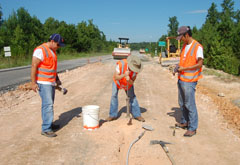| Wednesday, October 31, 2012 | ||
 |
 |
 |
| Past Issues | www.texasasphalt.org | Printer-Friendly | Subscribe | Advertise |
NCAT: Sold-Out Fifth Research Cycle Focuses on Reducing Pavement Life-Cycle Cost
We would like to thank our partners at The National Center for Asphalt Technology for the following article: An unprecedented amount of real-world, accelerated pavement testing will take place during the current fifth cycle of NCAT’s Pavement Test Track (2012-2015). The cycle sold out by early summer, with a total of 45 sections being sponsored by highway agencies and private industries.
Twenty-five of those sections remained in place from the fourth (2009) research cycle for further trafficking and evaluation, and 20 sections have been newly constructed. A track "sell-out" technically occurs when the 26 tangent sections — those located on the straightaways—are sponsored, so that target was well exceeded for the fifth cycle.

"By the time track reconstruction began this summer, the tangents were sold out and sections were being located in the curves wherever practical," explains Test Track Manager Buzz Powell.
Fifteen of the traffic-continuation sections will be evaluated for mix performance, and 10 are structural sections. The new construction includes 11 mix performance and nine structural sections.
The warm-mix asphalt (WMA) and reclaimed asphalt pavement (RAP) sections remaining in place from the fourth cycle are part of the track’s first Preservation Group (PG) experiment. Pavement preservation treatments ( thin overlays and inlays, microsurfacing, chip seals and other surface treatments) will be applied when these sections reach a predetermined level of distress, and they will continue to be monitored.
Preservation treatments will also be applied to Lee County Road 159 (LR 159), which provides access to a quarry and an asphalt plant. The beginning pavement condition on this road varies from good to poor. Varying levels of pretreatment distresses mapped within 100-foot test cells on LR 159 will provide a starting point for monitoring the change in performance curves that occurs after the various preservation treatments are applied. Test track sections will be used to define performance curves for interstate type pavements. At the end of the experiment, sponsors (state DOTs) will take away a quantified relationship between pretreatment pavement condition and the amount of time/traffic it takes for a pavement to return to its pretreatment condition. Unique performance curves will be defined for each preservation treatment.
"This (PG) approach will avoid any bias in the outcome that would have resulted from directly comparing preservation treatments on roads with different underlying support and traffic conditions," Powell says. "State DOTs will be able to take the results and use them in their preservation selection processes to objectively determine the most cost-effective treatments for their own roads."
Secondly, NCAT researchers involved in the PG study will quantify the life-extending benefit of these preservation treatments by comparing each treatment’s performance curve to that of an untreated control section. Powell says this will be a valuable tool for highway program managers who need to prioritize investments in pavement preservation.
Seven state DOT sponsors are funding the track PG study: Alabama, Mississippi, Missouri, North Carolina, Oklahoma, South Carolina and Tennessee. Another sponsor, FP2 (formerly known as the Foundation for Pavement Preservation), is also funding the experiment as an equal partner with the DOTs.
The PG study goes hand-in-hand with the overall focus of the fifth research cycle, which Powell says is "minimizing the life-cycle cost of asphalt pavements through using innovative materials during construction and selecting the best preservation alternatives under traffic."
Four sponsors (Alabama, North Carolina, South Carolina, and Tennessee DOTs) are supporting another group experiment known as the Green Group. This experiment will compare the performance and structural responses of test sections using recycled materials. The goal is to reduce initial pavement costs and extend pavement lives at the same time by combining high recycled content mixtures with perpetual pavement design principles. Four new test sections have been built in this experiment; each section will be composed of a surface layer, an intermediate layer and an asphalt base layer.
All the mixes used in the Green Group were produced using WMA technologies. A control section used RAP contents typical of current specifications—20 percent in the surface layer and 35 percent in the intermediate and base layers. The second section has a stone-matrix asphalt (SMA) surface layer containing 25 percent RAP, a high-modulus intermediate layer with 50 percent RAP, and a strain-tolerant base layer containing 35 percent RAP and a highly modified binder.
The third Green Group section has an SMA with 5 percent post-consumer shingles and no added fibers. The intermediate layer contains RAP and recycled shingles to have a 50 percent recycled binder content. The base layer for this section was also designed to be more strain tolerant than the control section base. It contains 25 percent RAP and a PG 76-22 binder. This section was designed to optimize the use of ground tire rubber (GTR), so the surface layer is an SMA with GTR and no added fibers. The high-modulus intermediate layer has 35 percent RAP and a GTR-modified binder. The base layer is a strain-tolerant gap-graded asphalt-rubber mix with 20 percent GTR by weight of asphalt.
Both the PG study and the Green Group are intended to help sponsors stretch transportation dollars—a need that garnered a great deal of interest in track sponsorship this cycle.
"State DOTs want to consider materials that will reduce the cost of pavement construction, but they need to implement changes in a way that does not negatively impact pavement life. The track is a tool that allows them to do that," Powell says. "Also, dwindling funding is forcing states to implement pavement preservation."
Four new sponsors came on board for the fifth research cycle. The Virginia Department of Transportation is the state DOT newcomer, sponsoring two surface performance sections and three structural performance sections built using a very green approach—all three sections’ base layers were produced with 100 percent RAP using cold, central-plant recycling and foamed asphalt. The Alabama Department of Environmental Management was the first non-DOT state agency to join any cycle, funding a structural section to focus on using recycled tires in pavement construction.
FP2 joined the cycle to partner in the PG study, and the private industry Modified Asphalt Solutions is helping fund the continued evaluation of a GTR-modified section built by the Missouri DOT for the fourth research cycle.
Trafficking for the 2012-2015 Pavement Test Track cycle began the first week in October. |
Asphalt: Smooth | Durable | Quiet | Safe





